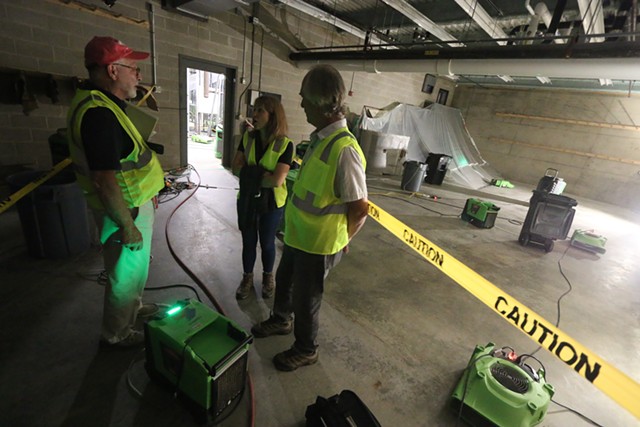
- Kevin McCallum ©️ Seven Days
- Pavilion Building basement
Just three years after COVID-19 emptied desks and workstations at the Vermont Department of Taxes, employees went through another round of upheaval, this one caused by the July flooding that devastated Montpelier.
The tax department building, which abuts the Statehouse lawn, was one of the hardest-hit structures in the Capital City’s state office complex. The basement was flooded, and the electrical system was knocked out of order for at least 90 days. Commissioner Craig Bolio moved essential on-site operations to office space in the National Life office complex, and many are working remotely again.
Adjustments made during the pandemic came in handy. Bolio knew right away that while most of the staff could move to remote work, a core of 30 to 40 people who open and sort physical mail would need a workspace. The large scanners that the tax department uses for paper tax returns and checks would need to move to National Life, too. While it took weeks to sort this out in the pandemic, it only took days this time around.
“The lesson that COVID taught us was to understand what your needs are for continuing operations,” Bolio said.
Related Rising Rivers Cause Catastrophic Flooding in Montpelier, Barre
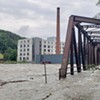
Rising Rivers Cause Catastrophic Flooding in Montpelier, Barre
News
A total of 20 state buildings were flood damaged, according to Fitch.
Some weathered the event. A biomass heat plant constructed with flood-mitigation measures came through with its systems intact, Fitch said.
The Agency of Transportation building had undergone flood-proofing work within the past five years and sustained little damage.
But others that hadn’t, including the Vermont Arts Council (housed in the birthplace and former home of former U.S. senator Patrick Leahy), the Green Mountain Care Board, and the Auditor’s Office buildings, sustained water damage not only to their basement but also to the first floor.
The state has to go through a planning process with the Federal Emergency Management Agency before it can make permanent repairs.
“If we took any one of those buildings and put Sheetrock on the walls, we risk our ability to leverage FEMA funding moving forward,” Fitch said.
On the other side of the street — once considered a lower priority for flood-proofing — the damage was severe. The Statehouse, on a rise, was spared flooding from the river, although some water did get in from hillside runoff, Fitch said. But the Supreme Court building and the Pavilion Building — which holds offices for the treasurer, the attorney general and the governor — will likely take months to fix.
The state plans to install interim electrical and other systems, and Fitch expects tenants to return to the tax department, Supreme Court and Pavilion Building if they want to, within 90 days. However, if there is a tenant that cannot operate without an elevator, she said, the building will remain closed until the elevators are fixed, which could take several months.
Related 'Major Disaster' Declaration Unlocks Millions in Federal Flood Aid for Vermont

'Major Disaster' Declaration Unlocks Millions in Federal Flood Aid for Vermont
News
“When you look at buildings as large as the tax building and the Pavilion and the Supreme Court, with large basements and large subbasements, it took us four to five days to pump them out completely because there was so much water,” Fitch said. “That means those building systems were under floodwater for four to five days.”
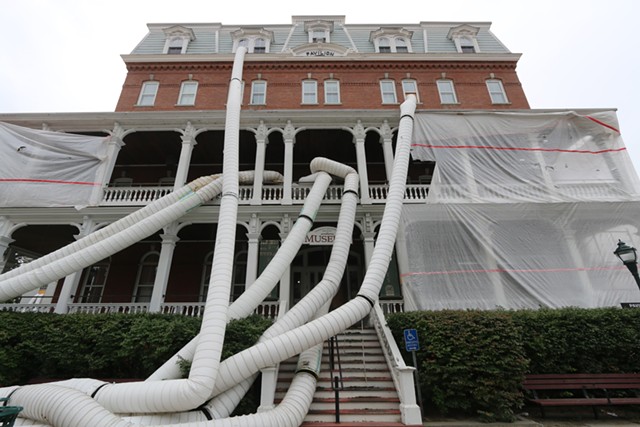
- Kevin McCallum ©️ Seven Days
- Pavilion Building
Montpelier’s two pedestrian tunnels — one that runs underneath the Statehouse lawn between the Pavilion and the tax department, and another from the tax department to an office building on Baldwin Street, next to the Statehouse — were also flooded almost to the ceiling.
Buildings and General Services had recently set up a small self-serve fresh food kiosk in the basement of the tax department, which once held a café popular with state workers who could use the tunnel to avoid the winter cold. That kiosk was destroyed, Fitch said. She’s not sure it will be replaced.
“It’s really going to come down to how we flood-proof 133,” she said of the tax department building, 133 State Street. “If we can do something to keep the water out, I’ll put it back where it was.”
Chairs, rugs and other Statehouse furnishings stored in the basement of the Pavilion were destroyed. Many had been there since the Statehouse committee rooms were reorganized during the pandemic, state curator David Schutz said. Many items had been placed on shelves but not high enough to escape the water. One of his last acts before evacuating the building was to make sure a settee was lifted off the floor and onto a shelf. It was ruined.
“We figured that would be good to go,” Schutz said. “Not so.”
Some damaged furniture will be refurbished in Quechee, Schutz said. A number of glass light fixtures survived immersion.
Twelve years ago, it cost $160 million to repair and flood-proof the Waterbury state office complex, which Fitch said has roughly half the office space of the Montpelier buildings.
The state has published a rough damage assessment but hasn't completed a detailed one with a cost estimate. After the flood, Gov. Phil Scott designated Doug Farnham, the deputy secretary of administration, as the state’s chief recovery officer, responsible for coordinating the complex state and federal programs that will be tapped to help repair homes, businesses and state property.
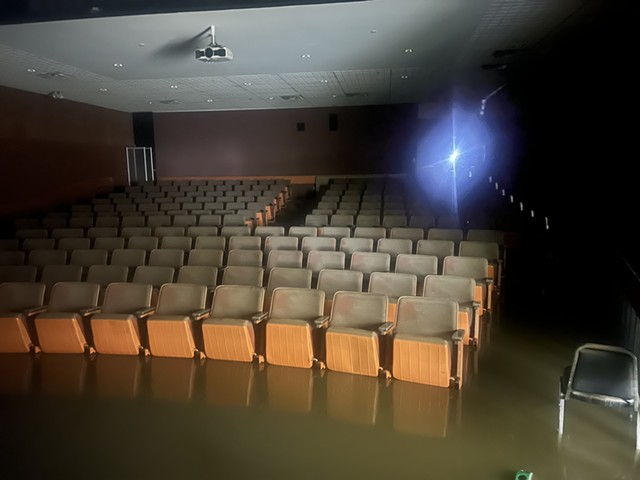
- Courtesy Vermont Department of Buildings and General Services
- Pavilion Building basement auditorium
The state will apply for aid from the National Flood Insurance Program and FEMA. It’s insured with two companies, CNA Financial and Lloyd’s of London, which are both doing cost assessments.
The Burlington architecture firm Freeman French Freeman, which worked with the state to rebuild the Waterbury complex after it was damaged by flooding in Tropical Storm Irene in 2011, has been retained to work on the flood mitigation measures in Montpelier. Fitch said the state will look at a number of strategies, such as installing pump systems, adding new sealants to basements and installing a flood wall around the buildings. Electrical panels and other systems will be moved to higher ground.
“It's hard to see the immediate benefit, but we learned from Irene that mitigation projects are a good investment of funds,” Farnham said. “Not only do you prevent suffering, you prevent financial loss and the disruption of everyone’s lives.”
“I have folks relocated all over the place,” Fitch added.
Among them are Gov. Scott and his staff, who were displaced from their fifth-floor offices in the Pavilion and have settled in at Vermont Agency of Transportation space in Berlin.
Many of the senior staff share a large room, Scott spokesperson Jason Maulucci said.
“It has a high school study hall vibe to it,” he said. “We’re at our own little tables.”

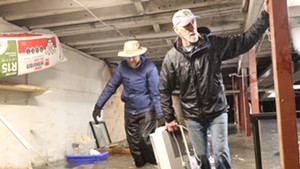





Comments
Comments are closed.
From 2014-2020, Seven Days allowed readers to comment on all stories posted on our website. While we've appreciated the suggestions and insights, right now Seven Days is prioritizing our core mission — producing high-quality, responsible local journalism — over moderating online debates between readers.
To criticize, correct or praise our reporting, please send us a letter to the editor or send us a tip. We’ll check it out and report the results.
Online comments may return when we have better tech tools for managing them. Thanks for reading.